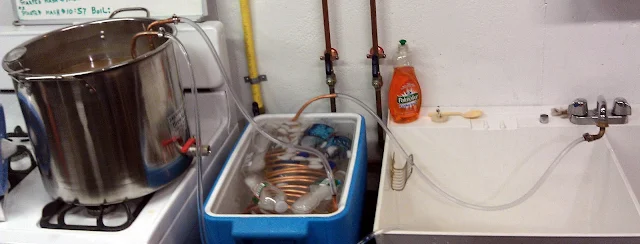Every brewer eventually faces the same moment. The wort looks rich, the
fermentation seems fine, but the finished beer lands too heavy. Too sweet. Too
slow to fade from the palate. Something in it refuses to dry out.
The problem is rarely the yeast. More often, it lies in the
chemistry that came before fermentation. The mash may have left behind complex
sugars that yeast simply cannot touch. That’s whereglucoamylase steps in. This enzyme has become the quiet workhorse of modern
homebrewing, transforming beers that feel unfinished into clean, dry, and
precise expressions of grain and yeast.
When used thoughtfully, glucoamylase doesn’t just change the
numbers on a hydrometer. It
reshapes mouthfeel, balance, and alcohol yield. It can push a sluggish
fermentation across the finish line or turn an overly sweet beer into something
lean and bright.
This isn’t about shortcuts or tricks.
It’s about control,
about understanding how to harness biology to perfect the art of fermentation.
Understanding Glucoamylase: The Enzyme That Finishes the
Job
Brewing is built on enzymes. They are the silent agents that transform raw
starch into the sugars that make beer possible. Among them, glucoamylase holds
a special role.
Glucoamylase, also known as amyloglucosidase,
is an enzyme most often produced from fungi such as Aspergillus niger.
Its purpose is to break the last remaining bonds in starch molecules,
converting long, stubborn dextrins into single glucose units. It works by
hydrolyzing both the alpha-1,4 and alpha-1,6 glycosidic linkages that connect
those carbohydrate chains.
In a typical mash, brewers rely on alpha-amylase and
beta-amylase to handle most of the starch conversion. Alpha-amylase chops the
starch into smaller fragments, and beta-amylase turns many of those into
maltose, the two-sugar molecule yeast loves. But both enzymes leave behind dextrins, which yeast cannot
ferment. Glucoamylase finishes the
process that alpha and beta begin. It strips every possible glucose molecule
from those leftover chains, transforming what would have been body-building
carbohydrates into fermentable fuel.
The result is a wort with higher fermentability and more
predictable attenuation. In effect, glucoamylase cleans the table after the
mash, ensuring nothing is left behind that the yeast cannot use.
Why Homebrewers Use Glucoamylase: Science Meets Strategy
For the modern homebrewer, glucoamylase is a tool of precision. Its value lies
in its ability to make fermentation complete. By converting dextrins into
glucose, it pushes yeast to work longer and more efficiently, producing a drier
beer with less residual sugar.
This is essential in certain styles. Brut IPAs, for
instance, depend on glucoamylase to achieve their champagne-like dryness
without stripping away hop aroma. Low-carb
or keto-friendly beers use it to remove every last fermentable
carbohydrate. In high-gravity ales like imperial stouts, tripels, or strong
lagers, the enzyme can prevent fermentation from stalling by giving yeast an
easy, steady source of glucose late in the process.
It’s also a reliable troubleshooting ally. When a
fermentation stops short of its target gravity, a small dose of glucoamylase
can restart the process, giving yeast something simple to consume.
Brewers use
it to fine-tune balance, cutting sweetness from malt-forward beers or
sharpening the finish of an experimental hybrid like a hoppy saison or dry
porter.
Scientifically, the effect is straightforward. Yeast
preferentially consumes glucose because it’s the simplest sugar to metabolize.
By converting leftover carbohydrates into glucose, glucoamylase extends the yeast’s active life
and deepens the fermentation curve. The payoff is a beer that feels leaner,
more stable, and more refined.
How and When to Use Glucoamylase in Brewing
The beauty of glucoamylase lies in its flexibility. It can be added at
different stages depending on the brewer’s intent, but timing and temperature
control are everything.
Used too early or too late, it can overshoot dryness or
waste its potential.
Used precisely, it becomes a scalpel.
In the Mash
Adding glucoamylase during the mash is ideal when you want full control over
fermentability from the start. The enzyme works best between 55°C and 65°C,
where it steadily converts residual dextrins into glucose.
The mash
pH should sit around 5.0 to 5.5 for maximum activity. Many brewers will
introduce it at the tail end of a standard saccharification rest, holding
temperature for 20 to 30 minutes. This allows alpha and beta amylase to do
their normal work first, and then glucoamylase steps in to finish the
conversion.
When used in this way, you’ll notice the wort’s gravity drops
faster than usual and the resulting beer ferments out almost completely.
In the Fermenter
This is the most popular method among homebrewers because it’s simple and
efficient. A small amount of glucoamylase (typically 1 to 2 ml per 20 liters of
wort) can be added once fermentation begins. The enzyme remains active through
most of the fermentation window, working alongside the yeast to continue
breaking down complex sugars.
Because it’s active at typical fermentation
temperatures (18°C to 25°C), the yeast consumes the newly released glucose
immediately, ensuring clean, steady attenuation.
The process is self-regulating
since the yeast depletes the sugars as they appear.
In Secondary or Conditioning
Some brewers experiment with glucoamylase post-fermentation to tweak sweetness
or balance in big beers. This approach requires caution because the enzyme
remains active as long as it isn’t denatured by heat or alcohol. If left
unchecked, it can create over-dry or over-carbonated beer.
Always monitor
specific gravity closely and stop enzyme activity by cold crashing or pasteurization
once the desired dryness is achieved.
Brewing Tips and Tricks from those brewers who have gone
before…
Glucoamylase isn’t a magic wand, it’s a precision instrument. The best brewers
use it sparingly and with intent.
Start Small. Enzymes are potent. Always begin
with a conservative dose and adjust over multiple brews. It’s easier to add
more next time than to fix a beer that finished too thin.
Watch the Gravity. Track fermentation daily.
When using glucoamylase, gravity can drop faster and lower than you expect. Aim
for your target dryness, then halt activity by cooling or stabilizing.
Match the Yeast. Some yeast strains,
especially those adapted to high-attenuation environments like champagne or
saison strains, respond beautifully to glucose-heavy conditions. Others can
produce unwanted fusels or off-flavors if fermentation runs too hot or too
long. Pair your enzyme use with a yeast known for clean fermentation at
moderate temperatures.
Kill It When You’re Done. If you add
glucoamylase during fermentation, it stays active. The simplest way to
deactivate it is to raise the temperature above 70°C, but that’s not practical
for finished beer. Instead, cold crash
and hold near 0°C to slow enzymatic activity before packaging.
Use It to Fix, Not Mask. Don’t rely on
glucoamylase to “rescue” poor recipe design. It can help with balance and
dryness, but it won’t fix bad malt choices or incomplete mashes. Use it to
refine, not conceal.

Using Glucoamylase in Different Beer Styles – from Light
Lagers to High-Gravity Ales
Glucoamylase has become a key player in modern craft
experimentation because of how it reshapes beer texture and fermentation
profile.
Brut IPA: The style that made this enzyme famous. Its
hallmark dryness comes directly from glucoamylase working alongside hop-forward
fermentation. The result is champagne-like crispness that lifts hop aromatics
without the sticky malt finish.
Low-Carb and Light Beers: Perfect for brewers chasing
low-carb or gluten-reduced beers. By breaking every dextrin into glucose,
glucoamylase minimizes residual carbohydrates. This creates clean, bright beers
that taste fuller than their calorie count suggests.
High-Gravity and Imperial Styles: Strong beers often
stall because yeast struggles to metabolize complex sugars in alcohol-rich
environments. Adding glucoamylase ensures continuous sugar availability,
preventing incomplete fermentations and overly sweet results.
Experimental and Hybrid Brews: Some brewers use
glucoamylase in sours or mixed fermentations to keep the base beer dry,
allowing wild microbes or fruit additions to take the spotlight. Others use it
in cider and mead to push
dryness and enhance perceived acidity.
Ultimately, the enzyme invites creativity. It lets brewers
sculpt sweetness, texture, and finish with precision that would otherwise take
years of trial and error.
The Science Behind the Sip: What’s Really Happening when amylase
is used in brewing
To understand
why glucoamylase works so
effectively, it helps to zoom in on what’s happening at the molecular
level. Starch is a complex carbohydrate built from long chains of glucose
molecules linked by alpha-1,4 and alpha-1,6
glycosidic
bonds. During
mashing,
alpha-amylase cuts these chains into shorter pieces while beta-amylase snips at
the ends to create maltose.
But both enzymes leave behind bulky dextrins,
which resist further breakdown.
Glucoamylase is the enzyme that finishes the disassembly. It
attacks both types of bonds, alpha-1,4 and alpha-1,6, working methodically from
the non-reducing ends of the chains until only single glucose molecules remain.
That glucose becomes the yeast’s preferred food source. Because yeast can
metabolize glucose faster and more completely than any other sugar, the result
is a more efficient fermentation and a cleaner finish.
This process has a noticeable impact on flavor chemistry as
well. When yeast consumes simple sugars like glucose, it tends to produce fewer
byproducts such as esters and higher alcohols, resulting in a more neutral,
balanced profile. That’s why glucoamylase beers often taste crisp and refined
even at high
attenuation. By giving yeast an easier diet, you also give yourself more
control over the sensory outcome.
There’s another layer to the science. As glucose levels
rise, yeast shifts its metabolism toward respiration suppression, known as the Crabtree
effect. This encourages full fermentation even in the presence of oxygen.
The overall result is consistency.
The brewer gains command over yeast
behavior, ensuring that every batch ferments predictably to its target dryness.

Troubleshooting and Fine-Tuning
Glucoamylase gives precision, but it also demands respect. Used carelessly, it
can over-dry a beer, strip its body, or alter carbonation levels after
packaging.
If the final
gravity dips below your target and the beer tastes thin, you likely used
too much enzyme or left it active for too long. In future batches, cut your
dosage in half and monitor gravity daily. You can also try denaturing the
enzyme earlier by pasteurizing the wort post-mash or cold crashing sooner in
fermentation.
If fermentation stalls midway, it usually means the enzyme
wasn’t given ideal conditions. Check pH and temperature - glucoamylase is most
active between 55°C and 65°C, but becomes sluggish below 20°C. Ensure you
didn’t shock the yeast with sudden temperature drops.
A small nutrient
boost and gentle rousing can help the yeast recover once sugars start
breaking down again.
If glucoamylase
remains active after packaging, it continues to generate fermentable sugars,
leading to over-carbonation or even bursting bottles.
Always verify final
gravity stability for several days before bottling. Cold stabilization or a
brief pasteurization step can deactivate residual enzyme activity.
Some yeast strains respond poorly to excessive glucose,
creating fusel
alcohols or solvent-like notes. This can happen if fermentation runs too
warm or if the yeast strain isn’t suited for rapid sugar metabolism. Keep
temperatures steady and use clean fermenting strains like American ale, Kölsch,
or neutral Belgian yeasts when working with glucoamylase.
The key to fine-tuning is observation. Keep detailed brew
logs. Track temperature, pH,
enzyme dosage, and timing.
Once you’ve brewed with glucoamylase a few times,
its behavior becomes predictable, and you’ll be able to dial in exactly how dry
you want your beer to finish.



































